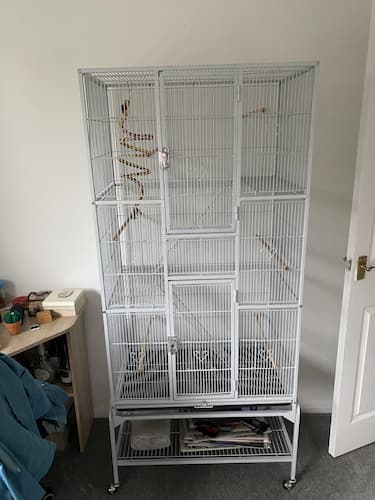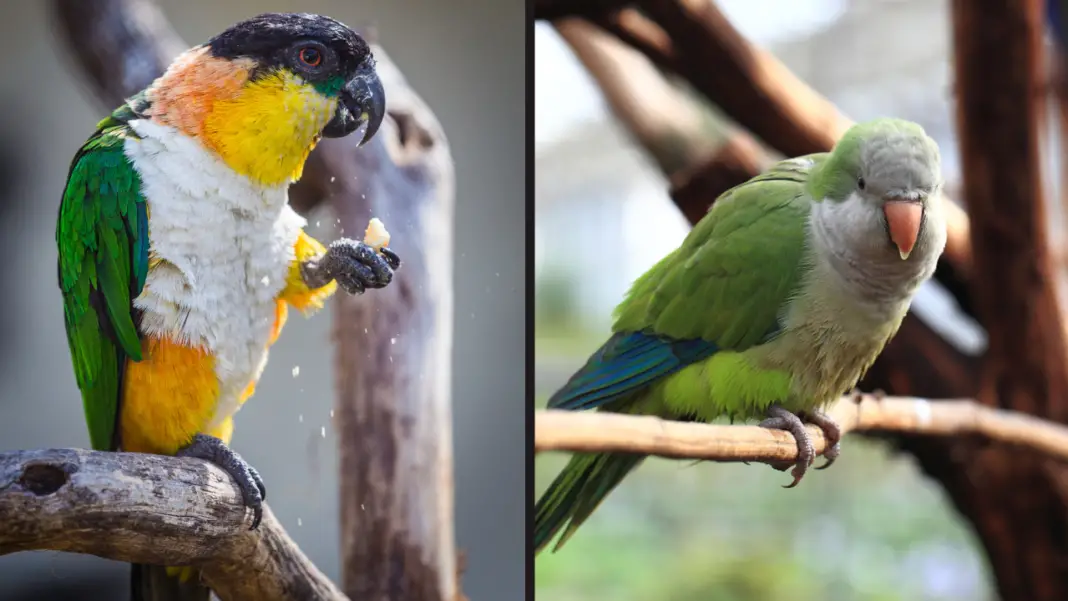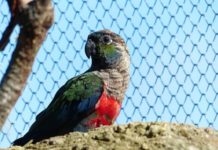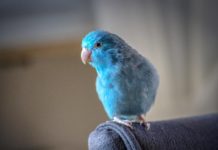Choosing a bird for a companion can be an exciting time. Caiques and quakers are unique birds and are relatively robust, long-lived, easy to care for, and defiantly entertaining. While there‘re many pet bird species available at pet stores and online classifieds, you may have narrowed your choice down to a species of either caique or quaker.
Both caiques and quakers have similar care requirements, needing a medium-sized cage, a healthy diet, along with plenty of social interaction.
How Long Do Caiques And Quakers Live?
The caique and quaker are long-lived birds that provide many years of companionship and entertainment. Quakers can live up to 30 years in captivity, although the vast majority live to around 20 years of age.
Caiques on the other hand frequently reach 30 years in captivity, with the oldest caique kept as a pet reaching the age of 34. It’s important to take into consideration that both of these birds are incredibly long-lived and require a lifetime of care which could be a substantial financial and emotional responsibility.
Caique Or Quaker – Which Bird Is More Colorful?
Adult quakers’ typical colors are a vivid green on the head, wings, and back. The quakers’ most distinguishing feature is their grey breast, cheeks, and throat. The quakers coloration resembles Colonial-era Quaker clothing and is how this bird got its name.

They also have gorgeous blue flight feathers with a lighter green tinge on the underside of their tails.
The markings of a caique are very distinct, as they have more of a color-blocked look. Their heads, wings, bellies, and thighs tend to be a vivid/distinct color from their other body parts, with few gradients between the colors. Caiques are often referred to as the seven-colored parrot because of their highly defined and colorful feathers.
Which Bird Is More Active?
Both birds are very similar to each other when it comes to their activity level, so both caiques and quakers require plenty of exercise. Both are very intelligent and curious and enjoy being around other company, whether it be other cage companions or around humans. Regardless of which you choose, be prepared to offer your bird plenty of one-on-one time, along with lots of time spent outside the cage to keep them both mentally and physically stimulated.
Both the caique and quaker need toys as a continuous stream of original and unique satisfaction of the bird. Other than toys, both caiques and quakers love to climb. You’ll need to make sure to have plenty of horizontal perches within the enclosure to exercise the bird when you aren’t there.
Personality
Caiques are known for forming strong bonds with their owners. Caiques love attention. They can be affectionate and enjoy playing with humans or even just sitting with their owner. They love showing off and are commonly referred to as the “dancing parrot”. Caiques are quick learners and are adept at picking up fun tricks and have great personalities.
Quakers are very confident and social birds by nature. Like caiques, quakers are very entertaining; they’re like little clowns. They have a large personality, something that you would expect of large birds in a little bird’s body. These birds are bold and outgoing and tend to chatter a lot and are known for their exceptional talking ability. It’s important to note that these birds are much louder compared to caiques.
Do Caiques And Quakers Use The Same Size Of Cage?
Although caiques and quakers are small to medium-size birds, they are extremely active and energetic birds. These birds’ overall health and well-being will suffer if they’re kept in a cage that’s too small. At a minimum, caiques and quakers should be kept in a 24 x 24 inch cage and at least 30 inches high. Although this cage size would be the minimum requirement for a single bird, the best rule to follow is to always get the biggest cage that your home and budget can afford.

When choosing a cage, you’ll want to ensure that the bars are made of strong steel to prevent the bird from getting out. Both caiques and quakers are extremely playful and intelligent and can quickly find a weak point of the cage to escape. You’ll also need to make sure that the bar spacing is small enough to prevent these types of birds from sneaking through.
Many bird owners recommend putting a bowl of fresh water inside the cage for a birdbath; doing this can provide hours of entertainment, exercise, and mental stimulation.
Quakers can be known for becoming aggressive if they feel their home is threatened. As they take pride in their home, many quakers quickly become possessive over their cage.
Where Is the Best Place To Buy A Caique Or Quaker?
Caiques and Quakers are widely available in the pet industry, especially on many pet classifieds on the internet. Of course, finding a caique or quaker from a shelter or a professional breeder is always the best option to find a healthy bird. You can expect to pay anything from $1,000 to $2,000 for a caique and around $400-$700 for a quaker, depending on the specific type of bird you want.
Do Caiques and Quakers need to be taken to the Vet Regularly?
Caiques and quakers are specialized birds that are regularly kept as pets. It’s always up to the owner to provide optimum care for their bird, including regular veterinary care. A healthy bird should be taken to the veterinarian for a wellness check once per year. It’s essential to take your caique or quaker to the veterinarian if you notice signs of illness or injury.
Conclusion
The best way to sum up quaker parakeets is that they are very sassy. Quakers like caiques are very affectionate and loving. It’s important to know that both of these birds will nip from time to time!
Quakers are also well known for their astonishing set of lungs and it can be very loud and high-pitched. So, depending on your living situation, i.e. you’re living in an apartment, then you may not want to keep one because of this.








